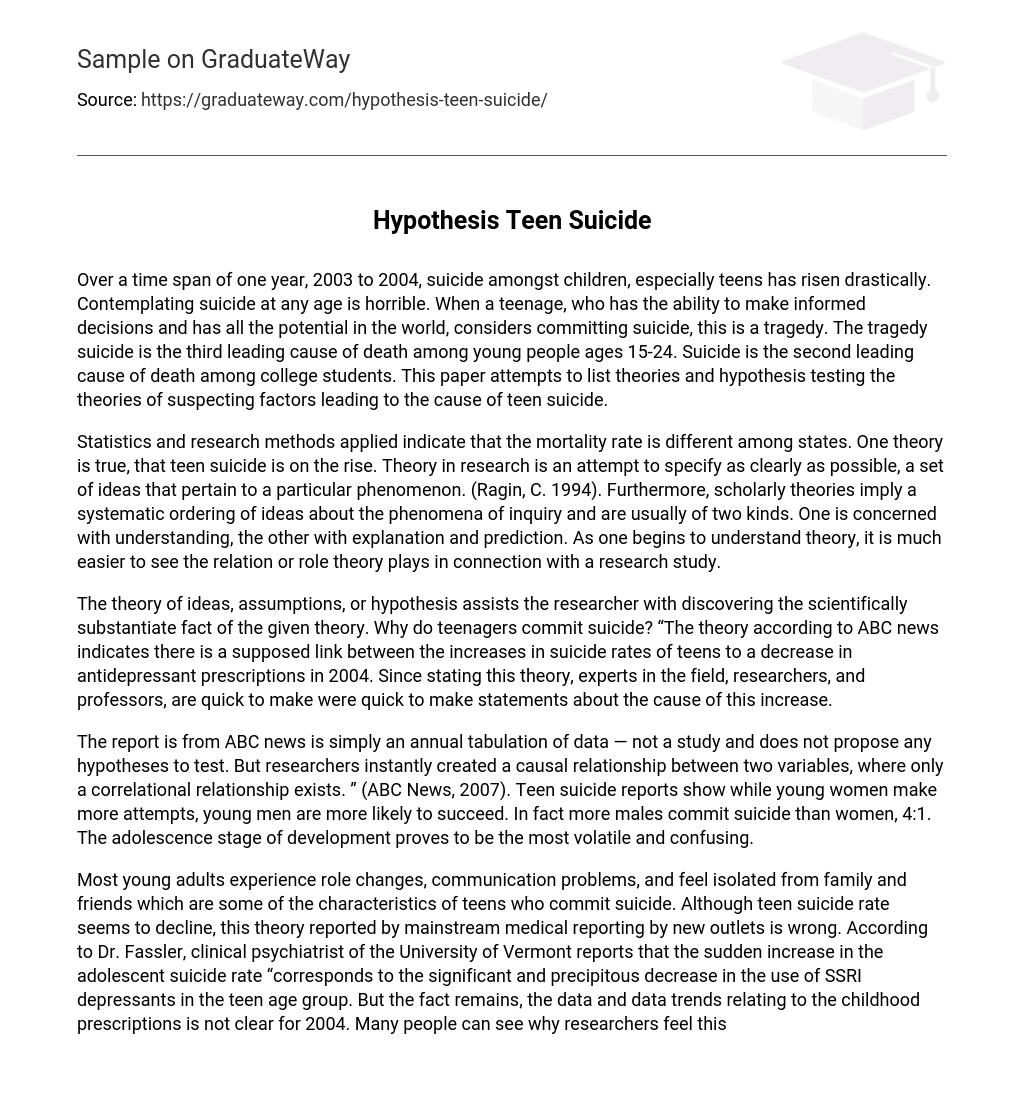Over a time span of one year, 2003 to 2004, suicide amongst children, especially teens has risen drastically. Contemplating suicide at any age is horrible. When a teenage, who has the ability to make informed decisions and has all the potential in the world, considers committing suicide, this is a tragedy. The tragedy suicide is the third leading cause of death among young people ages 15-24. Suicide is the second leading cause of death among college students. This paper attempts to list theories and hypothesis testing the theories of suspecting factors leading to the cause of teen suicide.
Statistics and research methods applied indicate that the mortality rate is different among states. One theory is true, that teen suicide is on the rise. Theory in research is an attempt to specify as clearly as possible, a set of ideas that pertain to a particular phenomenon. (Ragin, C. 1994). Furthermore, scholarly theories imply a systematic ordering of ideas about the phenomena of inquiry and are usually of two kinds. One is concerned with understanding, the other with explanation and prediction. As one begins to understand theory, it is much easier to see the relation or role theory plays in connection with a research study.
The theory of ideas, assumptions, or hypothesis assists the researcher with discovering the scientifically substantiate fact of the given theory. Why do teenagers commit suicide? “The theory according to ABC news indicates there is a supposed link between the increases in suicide rates of teens to a decrease in antidepressant prescriptions in 2004. Since stating this theory, experts in the field, researchers, and professors, are quick to make were quick to make statements about the cause of this increase.
The report is from ABC news is simply an annual tabulation of data — not a study and does not propose any hypotheses to test. But researchers instantly created a causal relationship between two variables, where only a correlational relationship exists. ” (ABC News, 2007). Teen suicide reports show while young women make more attempts, young men are more likely to succeed. In fact more males commit suicide than women, 4:1. The adolescence stage of development proves to be the most volatile and confusing.
Most young adults experience role changes, communication problems, and feel isolated from family and friends which are some of the characteristics of teens who commit suicide. Although teen suicide rate seems to decline, this theory reported by mainstream medical reporting by new outlets is wrong. According to Dr. Fassler, clinical psychiatrist of the University of Vermont reports that the sudden increase in the adolescent suicide rate “corresponds to the significant and precipitous decrease in the use of SSRI depressants in the teen age group. But the fact remains, the data and data trends relating to the childhood prescriptions is not clear for 2004. Many people can see why researchers feel this way because the data seems to support the data in SSRI prescriptions for teens and children in 2004. Another theory for the increase of teen suicide is the gender differences and sociological than psychological. Men are socialized to hide their feelings and to adjust to the pain caused by trauma.
According to Antoon Leenaars, President of the Canadian Associated of Suicide Prevention, states that socializing men to hide their feelings “emphasizes personal responsibility for not fitting into the dominant male culture. Male culture places no great emphasis on mutual support during adolescence, but rather thrives on competition. It is a culture, too, which has been weakened by the sexual revolution and is in the process of change. These factors show that suicidal impulses in young males have more to do with the egoistic model than the anomic model. This theory demonstrates that males could experience a decrease in low morale and self esteem, leading to more concerns surfacing later on in adult years. As with males, female stressors can result from an inability to deal with interpersonal conflicts, an unplanned pregnancy, or child abuse. Some stressors cause females to have suicidal thoughts and ideations. Underling women’s suicidal attempts the concepts of vulnerability to loss, inhibition of anger, inhibition of action and aggression and low self esteem are more likely to be a factor for females than for males.
The hypothesis was pursued by doctors in Sweden, who found that suicide was more closely associated with birth trauma than with any other of the 11 risk factors for which they tested, including such socioeconomic variables as parental alcoholism and a broken home. Among the medical community, the theories identified continue to be very controversial, rather than decreasing as these scientists advocate. In conclusion, 95 to 97% of teen suicide is preventable. 80% of teens attempting suicide have seen the doctor before.
Students complain of problems in school, fatigue, and insomnia. These signs should be seen as red alerts “something is wrong”. Seek help for your child. References Childs, Dan, 2007. Some Experts Blame FDA labeling on Child Suicide Increases. Retrieved November 23, 2009 from ABC New. com. http://abcnews. go. com/Health/Depression/story? id=2850783&page=1 Ragin, Charles C. (1994). The Comparative Method. Moving Beyond Qualitative and Quantitative Methods. Retrieved November 23, 2009 from http://www. soc. ucsb. edu/faculty/sutton/Design/Assets/Soc%20212A%





